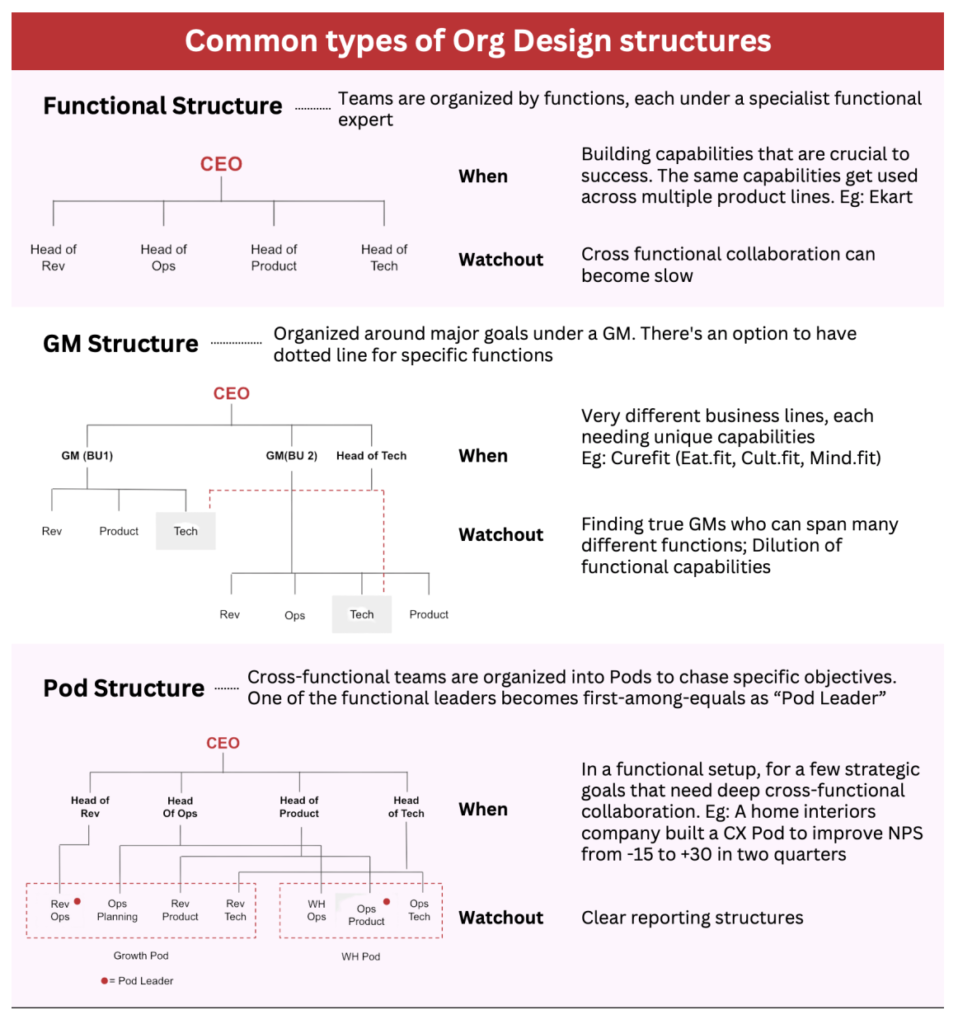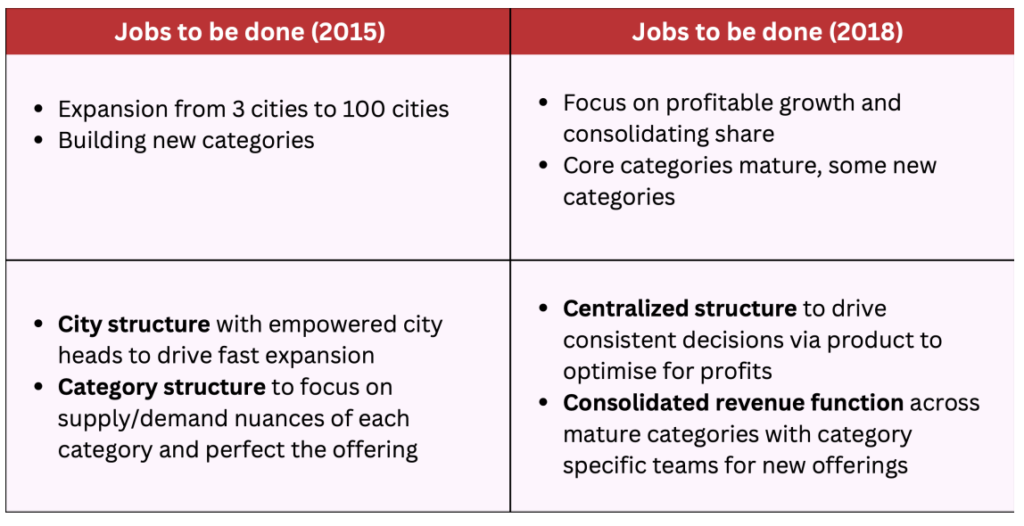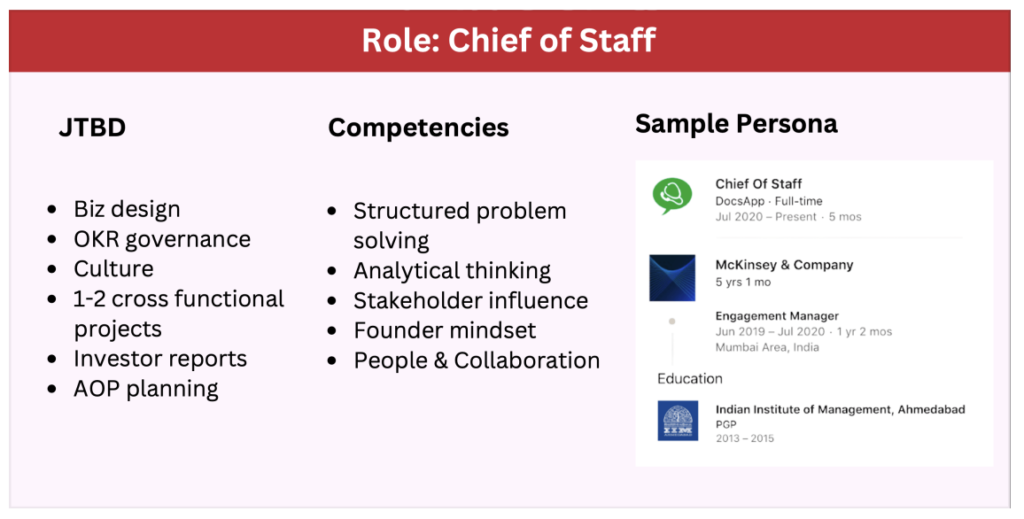As a founder, you are always setting ambitious goals to be achieved in a short period of time – this could be anything from a 5x growth in revenue to dramatic shift in NPS to becoming EBITA +ve.
But, is your org ready? Are you set up well to achieve these goals?
Having the right org design that’s aligned to the goals you are going after in the coming 12-18 months is akin to adjusting the sails of your ship to the direction of the wind.
So what is Org Design?
Org Design is the setup required to achieve your Strategy through the right Skills, Structure, Staffing and Systems (it is much more than the boxes and lines that typically come to mind).
1) Strategy: What do you want the org to accomplish?
Do you know what the big goals for the organisation are over a 12-18 month horizon? Do you know the key jobs to be done to get to these goals? Strategy sets the north star for org design. Any org design exercise without a clear strategy in place can quickly turn tactical, with incoherent permutations and combinations. Here are some examples of how strategy sets the direction:

2) Skills: Do you have teams to build the capabilities that matter?
If you know the direction you want to head in, do you have the capabilities or skills in the organisation to get there? We have noticed that many organisations are not aware of what these skills are. The earlier you find the skills needed to scale, the smoother your scaling will be. For example, did you know that we improved our last-mile productivity at Flipkart after we installed Ops Design as a thinking arm of Ops?
Here are a few other examples:

3) Structure: What is the most effective (and efficient) way to divide responsibilities and ensure real accountability for “L1/L2” metrics?
The right Structure can drive efficiency, decision-making accountability and focus. Most of all, the right structure clarifies the roles to people in the organisation. It also ensures that the founders and leaders spend a big chunk of their time on strategy, not on operating elements of the business. A fundamental structure choice you will encounter is between a functional, GM and a POD structure. Here is a rubric for you to think through this:

You will come across a series of similar org structure choices (City P&L vs Central, Category vs consolidated revenue ownership etc). The one simple rule I would recommend is to build out a rubric like the one above, consider your context and take a thoughtful decision. The other thing to keep in mind is that your structure will have to evolve as your org matures and your goals change. Here is an example of structure evolution in a mobility player over the years:

4) Staffing: Do you have the right (empowered) leaders in critical roles?
Staffing is about whether you have high-quality leaders and managers in the organisation doing important things. Is your best talent going after the most important problem statements of the organisation? Here is a framework for you objectively approach staffing decisions for critical roles in your org structure:

This level of detailing helps you make the right staffing decisions. In fact, I have heard multiple founders remark, “This helps me clarify that we need an external hire urgently” or “I thought of hiring someone from outside but we may very well take a bet on X”. It also helps you take the right talent call based on your context and stage: a high intrinsic generalist with 5+ yrs of critical exp may be better suited for your early stage setup vs 12+ yrs talent with experience of playing the role in mature startup.
I will conclude this section with a key principle that has always served me well:
Always look internally first before deciding to hire externally for a critical/new role.
5) Systems: Do you have processes that enable peak performance?
Systems is what we call the software of org design. These are what make the org design come to life. Examples are OKRs, NPS, Biz fin as a capability, forums such as town halls, office hours etc. I will skip the details considering each of them merits its own article.
I’ll conclude with a couple of pointers to keep in mind as you go about designing your org:
• Refresh every 12-18 months – This is the typical time frame to refresh your org design in alignment with your Strategy.
• Strategy -> Skills -> Structure -> Staffing is the ideal order. Absolutely avoid the temptation to take a talent-first view and then work backwards.
If you wish to speak further on any of these, feel free to reach out (via Calendly) to Arun Vigneswaran, who leads the People Excellence charter at xto10x. He and his team have successfully helped 40+ startups with their org design.

